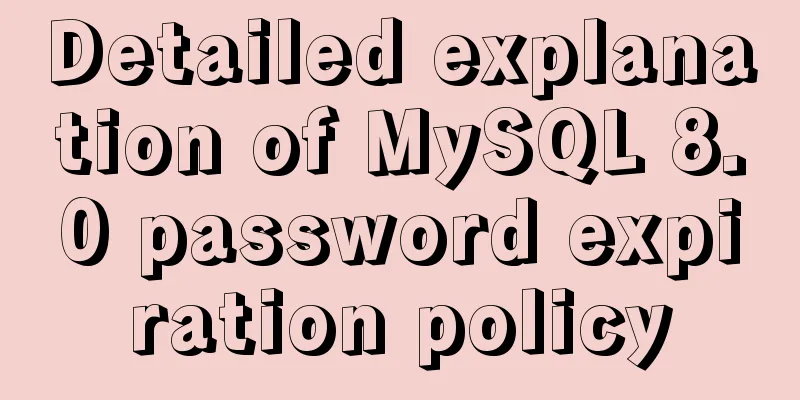Detailed explanation of MySQL 8.0 password expiration policy

|
Starting from MySQL 8.0.16, you can set a password expiration policy. Today, we will expand on this small knowledge point. 1. Manually set a single password expiration In MySQL 8.0, we can use the alter user command to expire the password. First we create the account yeyz, the password is yeyz [root@VM-0-14-centos ~]# /usr/local/mysql-8.0.19-el7-x86_64/bin/mysql -uyeyz -pyeyz -h127.0.0.1 -P4306 -e "select 1" mysql: [Warning] Using a password on the command line interface can be insecure. +---+ | 1 | +---+ | 1 | +---+ Here we expire it: mysql> alter user yeyz@'127.0.0.1' password expire; Query OK, 0 rows affected (0.01 sec) Let’s look at the connection again: [root@VM-0-14-centos ~]# /usr/local/mysql-8.0.19-el7-x86_64/bin/mysql -uyeyz -pyeyz -h127.0.0.1 -P4306 -e "select 1" mysql: [Warning] Using a password on the command line interface can be insecure. Please use --connect-expired-password option or invoke mysql in interactive mode. -- Prompt us to connect through the --connect-expire-password command, let's add it and see [root@VM-0-14-centos ~]# /usr/local/mysql-8.0.19-el7-x86_64/bin/mysql -uyeyz -pyeyz -h127.0.0.1 -P4306 --connect-expired-password -e "select 1" mysql: [Warning] Using a password on the command line interface can be insecure. ERROR 1820 (HY000) at line 1: You must reset your password using ALTER USER statement before executing this statement. -- Here we are prompted to execute the alter user syntax to change the password first, and then use the password. Of course, in addition to manually setting the password expiration, we can also set the password to never expire and specify the expiration time: -- Set the password to never expiremysql> create user yeyz1@'127.0.0.1' identified with 'mysql_native_password' by 'yeyz1' password expire never; Query OK, 0 rows affected (0.01 sec) -- Set the password expiration period to the specified number of daysmysql> create user yeyz2@'127.0.0.1' identified with 'mysql_native_password' by 'yeyz2' password expire interval 90 day; Query OK, 0 rows affected (0.01 sec) If we want to follow the global password expiration policy, we can use the default keyword: mysql> create user yeyz3@'127.0.0.1' identified with 'mysql_native_password' by 'yeyz3' password expire default; Query OK, 0 rows affected (0.01 sec) In this case, the time set by the parameter default_password_lifetime will be respected. 2. Set the global password expiration time. If we want all passwords to have an expiration time, we can configure the parameter default_password_lifetime. Its default value is 0, which disables automatic password expiration. If the value of default_password_lifetime is a positive integer N, it indicates the allowed password lifetime in days, so the password must be changed every N days. mysql> show variables like '%lifetime%'; +---------------------------+-------+ | Variable_name | Value | +---------------------------+-------+ | default_password_lifetime | 0 | +---------------------------+-------+ 1 row in set (0.00 sec) 3. Set the global password reuse time and the number of reuse intervals Please note that the reusable time, reusable interval and expiration time here are different concepts. The expiration time means that the password expires at this time and becomes unusable. Reusable means that the historical password can be reused only after a specified time, or after the password has been modified a specified number of times. We can set the reusable time of a single password, or the number of reusable intervals, by the following method: The expiration time indicates how long it will take before you need to change your password; The number of expiration times indicates how many times a new password can be set. These two functions require the use of parameters password_history and password_reuse_interval respectively. Let's test the password_history parameter: mysql> alter user yeyz@'127.0.0.1' identified with 'mysql_native_password' by 'yeyz'; Query OK, 0 rows affected (0.01 sec) mysql> mysql> show variables like '%password_history%'; +------------------+-------+ | Variable_name | Value | +------------------+-------+ | password_history | 0 | +------------------+-------+ 1 row in set (0.00 sec) mysql> set global password_history=2; Query OK, 0 rows affected (0.00 sec) -- First modification, successfulmysql> alter user yeyz@'127.0.0.1' identified with 'mysql_native_password' by 'yeyz'; Query OK, 0 rows affected (0.01 sec) -- Second modification, error reportedmysql> alter user yeyz@'127.0.0.1' identified with 'mysql_native_password' by 'yeyz'; ERROR 3638 (HY000): Cannot use these credentials for '[email protected]' because they contradict the password history policy mysql> As you can see, at the beginning, the password_history parameter is set to 0. We change it to 2, which means that the previous password can be repeated only after executing the password setting action twice, that is, the password modified this time is not allowed to be the same as the previous password. Then I started to change the password to the same password 'yeyz'. The first time I changed it, it was successful. When I set the password for the second time, I got an error message. This method is to set the number of valid passwords through system variables. 4. Set the time and interval for reusing a single password -- Set the password to be reused every 5 timesmysql> create user yeyz3@'127.0.0.1' identified with 'mysql_native_password' by 'yeyz3' password history 5; Query OK, 0 rows affected (0.01 sec) -- Set the password to be reused every 5 daysmysql> create user yeyz4@'127.0.0.1' identified with 'mysql_native_password' by 'yeyz4' password reuse interval 5 day; Query OK, 0 rows affected (0.01 sec) -- Set the password to be reused every 5 days or every 5 times, whichever is more stringent.mysql> create user yeyz5@'127.0.0.1' identified with 'mysql_native_password' by 'yeyz5' password reuse interval 5 day password history 5; Query OK, 0 rows affected (0.01 sec) -- Use the default global password reuse policy, that is, the password history parameter and the password reuse interval parameter mysql> create user yeyz6@'127.0.0.1' identified with 'mysql_native_password' by 'yeyz6' password reuse interval default password history default; Query OK, 0 rows affected (0.01 sec) The above is a detailed explanation of the MySQL 8.0 password expiration policy. For more information about the MySQL 8.0 password expiration policy, please pay attention to other related articles on 123WORDPRESS.COM! You may also be interested in:
|
<<: The process of installing and configuring nginx in win10
>>: vue+element custom query component
Recommend
MySQL stored procedures and common function code analysis
The concept of mysql stored procedure: A set of S...
MySQL 8.0.18 installation and configuration method graphic tutorial (linux)
This article records the installation and configu...
Summary of web designers' experience and skills in learning web design
As the company's influence grows and its prod...
Data constraint examples based on MySQL database and introduction to five integrity constraints
In order to prevent non-compliant data from enter...
A brief talk about calculated properties and property listening in Vue
Table of contents 1. Computed properties Syntax: ...
Use of MySQL trigger
Table of contents 1. Trigger Introduction 1. What...
Best way to replace the key in json object
JSON (JavaScript Object Notation, JS Object Notat...
XHTML Getting Started Tutorial: Form Tags
<br />Forms are an important channel for use...
React new version life cycle hook function and usage detailed explanation
Compared with the old life cycle Three hooks are ...
A brief discussion on the pitfalls and solutions of the new features of MySQL 8.0 (summary)
1. Create users and authorize Creating users and ...
Detailed explanation of count(), group by, order by in MySQL
I recently encountered a problem when doing IM, a...
Solution to the garbled code problem in MySQL 5.x
MySQL is a commonly used open source database sof...
html a link tag title attribute line break mouse hover prompt content line break effect
The method of wrapping the content (title attribut...
Detailed explanation of built-in methods of javascript array
Table of contents 1. Array.at() 2. Array.copyWith...
An example of using CSS methodologies to achieve modularity
1. What are CSS methodologies? CSS methodologies ...









